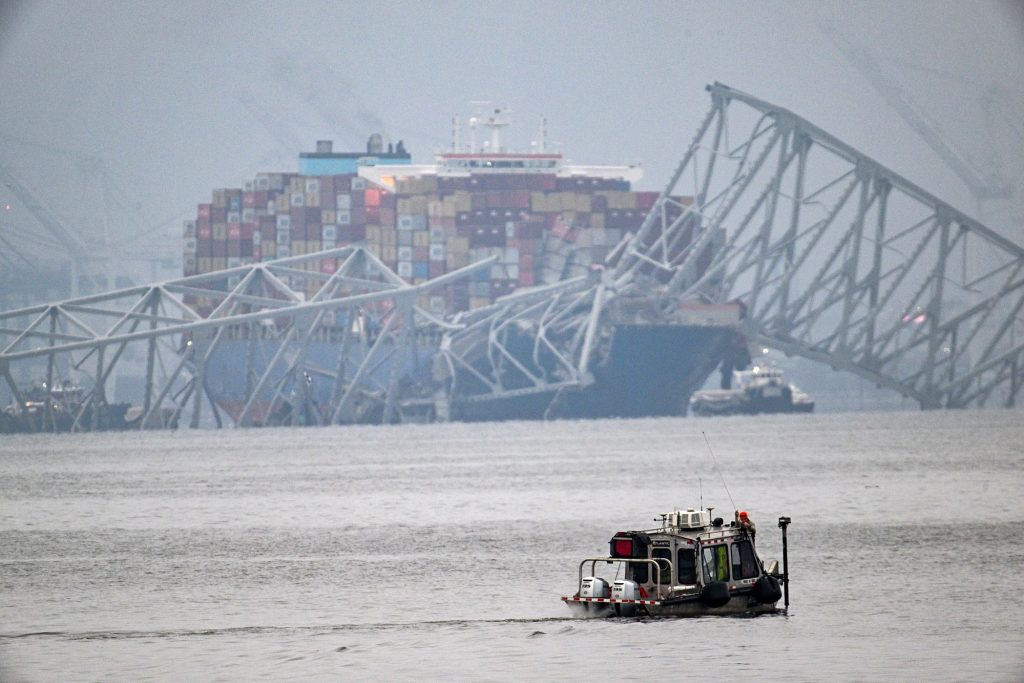The Francis Scott Key Bridge could return to the Baltimore skyline in as little as two years or as many as 15, with some experts considering a number in between.
The Key Bridge crossed the Patapsco River in Baltimore's outer harbor until early Tuesday morning, when a cargo vessel hit the bridge and sent it into the cold waters below. As of Wednesday, authorities are still searching for six missing construction workers who are presumed dead.
While authorities emphasized the need to focus on the recovery operation, questions have swirled about the rebuild of the Key Bridge — especially after President Joe Biden, a Democrat, said Tuesday that the federal government would “pay the entire cost of reconstructing” the bridge.
“Although this is a tragedy, and although we're all going to be terribly inconvenienced, it's people's lives and jobs in Baltimore if that port stays closed for very long,” said Benjamin W. Schafer, a structural engineer who specializes in steel structures and is an engineering professor at the Johns Hopkins University.
Scott Cowan, president of the International Longshoremen’s Association Local 333 in the Port of Baltimore, expressed similar feelings Tuesday, saying the halting of ships in and out of the port will be “disastrous” for the thousands of people employed at the port who are out of work without ship traffic.
But even with promised federal money, which comes with its own requirements and conditions, there are many factors that need to be considered before construction of any bridge can start, Schafer said, naming securing funding, deciding on a visual design, selecting materials and working out engineering queries as steps in the process.
In the case of the Key Bridge collapse, clearing the river of debris will also be a challenge. All said and done, Schafer estimated a rebuild could take as long as a decade or more.
“The bridge originally, it seems like it was about five years from breaking ground to opening up. In 1980, when the Tampa [Bay] Sunshine Skyway bridge had a collision and was destroyed, and then rebuilt with a new cable-stayed bridge, that took seven years. I would consider those lower bounds,” he said. “I think we’re looking at seven-plus, I would guess 10 to 15 years before — I know that sounds crazy — but before we look back over and we see a bridge jumping over the harbor.”
At an online event hosted by Hopkins Wednesday morning, Schafer said he’s “lived through quite a few civil infrastructure projects, and they’re rarely less than 10 years,” adding that the price tags “never seem to be out of the hundreds of millions these days.”
“Although I don’t think the transportation network will come back quickly, we can get the port back up,” Schafer said.
Schafer added that the “politics of getting to the moment of building the bridge can run on much longer than the actual building of it,” a claim already hinted at by state and federal officials.
“A special thanks to President Biden who made it very very clear that he will do everything in his power to make sure that we get the help we need to deal with this challenge,” said Sen. Ben Cardin, a Democrat, at a Tuesday news conference. “But as Secretary [Pete] Buttigieg told us in our briefings, he’s going to need the help of Congress to get things done.”
Congress could act quickly to rebuild, despite Biden's disagreements with the Republican majority in the U.S. House. In 2007, the I-35W bridge in Minneapolis collapsed, killing 13 and injuring nearly 150 people. Just a few days later, Congress authorized $250 million for the bridge's reconstruction.
Buttigieg, the federal transportation secretary, stated that his department is prepared to approve emergency funding upon request.
“This is no ordinary bridge. This is one of the icons of American infrastructure,” Buttigieg said. “So the path to normalcy will not be easy, it will not be quick, it will not be inexpensive, but we will rebuild together.”
Senate President Bill Ferguson, a Democrat from Baltimore, expressed satisfaction with Biden's commitment of federal funds for the reconstruction. The halting of vessel traffic in and out of the Port of Baltimore is likely to disrupt shipping and supply chains while the port stands to lose an estimated $15 million a day in economic activity.
Ferguson stated that there will be an investigation into the collision, followed by salvaging efforts. Rebuilding can’t start until after that.
“I think when we rebuild, we should rebuild for the 22nd century,” Ferguson said. “This was a 50-year-old bridge. We should assume that when we rebuild, it’s rebuilding for the next 50 to 75 years.”
Abieyuwa Aghayere, an engineering professor at Drexel University, emphasized that safety, cost, and sustainability are important considerations in bridge construction. Aghayere added that rebuilds must aim to eliminate any vulnerabilities that may have been present.
“You don’t want to repeat the same mistakes,” he said.
Aghayere believes the rebuild could be completed quickly, especially if promised federal funds come through.
“Because of the importance of 695 … I can see it being done within one to two years,” Aghayere said, adding that it can be difficult to estimate. “If all hands are on deck, I think it can be done.”
Cable-stayed bridges are now popular and a style that might work in the area where the Key Bridge collapsed, Aghayere said, adding that having bridge supports spaced farther away from each other would allow for a wider opening for ships to navigate.
A newly built Key Bridge might also likely include sensors to monitor its structural health, like those implemented on Delaware’s Indian River Inlet bridge completed in 2012, said Nii Attoh-Okine, the civil and environmental engineering chair at the University of Maryland.
“This is a very, very important bridge, not only for Baltimore, not only for Maryland, but for the eastern corridor,” he said. “It’s part of the supply chain.”
Rachel Sangree, an associate teaching professor at Hopkins in the engineering department and a former bridge inspector, noted that a future bridge will likely need to provide a route for handling hazardous materials, which can’t travel through tunnels, as the former bridge did.
“The Key Bridge was extremely tall, so whatever is chosen, it will have to support not only the current sizes of the shipping vessels, but also larger sizes, because we don’t want to design only for what we’re seeing right now,” Sangree said. “We always need to be thinking ahead.”
The Key Bridge was one of the city’s prominent landmarks, which also has its own set of design priorities, Schafer said.
“It holds significance for Baltimoreans, and for the region,” he said. “So I don’t think a simple, practical bridge would necessarily be built back. I think they’ll contemplate what they’re creating, and its aesthetics.”
Baltimore Sun reporters Hannah Gaskill, Jonathan M. Pitts and Dillon Mullan contributed to this story.









